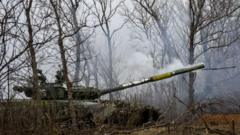The recent summit between U.S. President Donald Trump and Russian President Vladimir Putin in Anchorage, Alaska, concluded without any concrete agreements regarding a ceasefire in Ukraine. After nearly three hours of discussions, the two leaders delivered a joint statement but took no questions from the press. Trump acknowledged the lack of a deal, stating, "There's no deal until there's a deal," which raises concerns about his reputation as a negotiator.
Although some allies may be relieved that Trump did not offer concessions, the absence of a ceasefire agreement marks a significant setback for the U.S. and international efforts toward peace. There seems to be no immediate plan for another summit, particularly with Ukrainian President Volodymyr Zelensky included. Trump's silence during certain parts of the conference, particularly while Putin spoke, has also drawn criticisms regarding his leadership stance.
Following the summit, the uncertainty surrounding further U.S. sanctions against Russia looms large, with Trump hinting at possible measures but providing no clear timeline. Meanwhile, for Ukraine, the outcome of the summit feels like a relief that no adverse deal was struck, but the underlying fear of continued Russian hostility remains.
As the world watches, the future for Ukraine hinges on further developments in U.S.-Russia relations and the possibility of renewed military aggression from Moscow. The summit's lack of progress makes it clear that achieving peace will require more than just high-level discussions.
Although some allies may be relieved that Trump did not offer concessions, the absence of a ceasefire agreement marks a significant setback for the U.S. and international efforts toward peace. There seems to be no immediate plan for another summit, particularly with Ukrainian President Volodymyr Zelensky included. Trump's silence during certain parts of the conference, particularly while Putin spoke, has also drawn criticisms regarding his leadership stance.
Following the summit, the uncertainty surrounding further U.S. sanctions against Russia looms large, with Trump hinting at possible measures but providing no clear timeline. Meanwhile, for Ukraine, the outcome of the summit feels like a relief that no adverse deal was struck, but the underlying fear of continued Russian hostility remains.
As the world watches, the future for Ukraine hinges on further developments in U.S.-Russia relations and the possibility of renewed military aggression from Moscow. The summit's lack of progress makes it clear that achieving peace will require more than just high-level discussions.





















